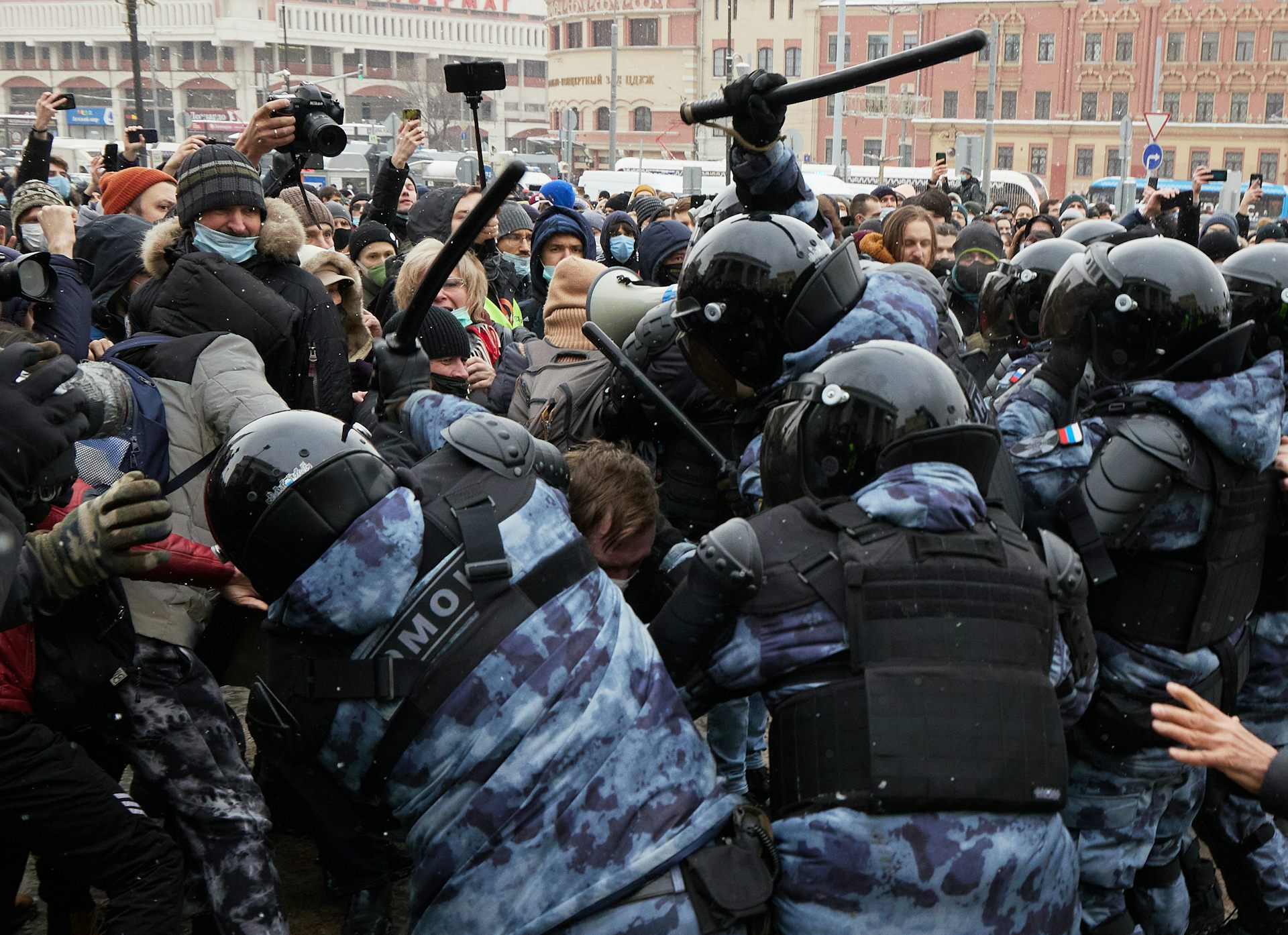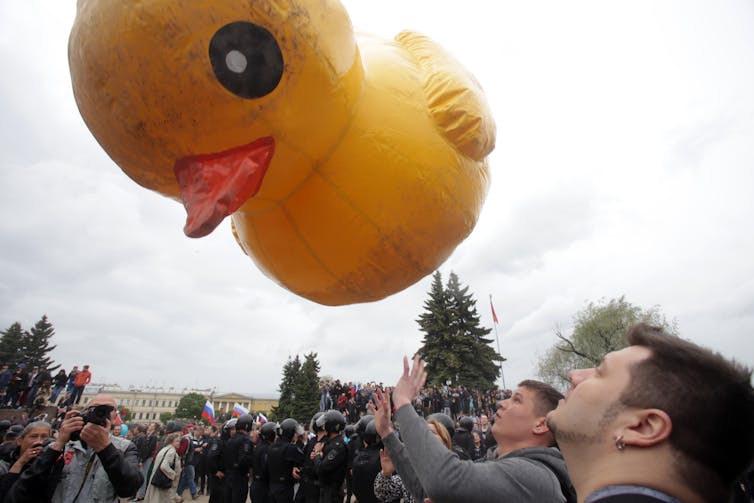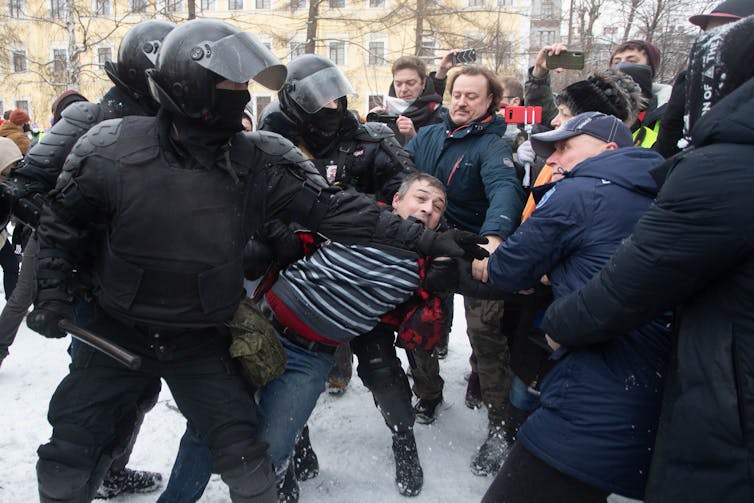
Russian opposition leader Aleksei Navalny and his team have stunned the Russian government again, forcing President Vladimir Putin and his allies to confront significant protest led by a foe they hoped to first sideline and, more recently, eliminate.
Navalny was nearly killed in August by the Novichok nerve agent in what most experts believe was an assassination attempt by the Kremlin. But he survived, after being airlifted from Russia to Germany, where he spent five months recovering.
The Kremlin discouraged Navalny from returning to Russia by revoking his probation on previous charges and issuing an arrest warrant.
In response, Navalny said, “Russia is my country, Moscow is my city, I miss them.” He flew back on Jan. 17 and was immediately detained.
Navalny didn’t go quietly: His call for protests against his detention brought Russians to the streets in late January, in the largest opposition events in a decade and the most geographically widespread actions since the late Soviet period.

A controversial leader
I write about Navalny’s opposition strategy in my book “Elections, Protest, and Authoritarian Regime Stability: Russia 2008-2020,” which explores the nature of Navalny’s threat to the Kremlin.
Since 2011, Navalny has been often quoted saying that his goal is to live in a normal country that is fair and can realize its economic potential. When he ran for Moscow mayor in 2013, his campaign slogan was “Change Russia, Begin with Moscow.”
Rivals in the opposition and in the regime dispute his motivations. During his early political career, Navalny espoused ethnic nationalist beliefs, and participated in the far right’s annual Russian March. He supported Russia’s 2008 invasion of Georgia and used racial slurs to call for the deportation of Georgians and illegal Central Asian migrants. This rhetoric generated enduring distrust among the democratic opposition.
Kremlin officials dismiss him as an ambitious megalomaniac, implying that he wants power and wealth. These claims limited his personal support.
Anti-corruption campaign
Navalny began as a lawyer, challenging the large Russian energy companies by buying stock and thus gaining the right to attend shareholders’ meetings. He used his access to confront corporate leadership, demanding transparent corporate governance.
He established the Anti-Corruption Foundation, or FBK, to collect citizens’ reports of corrupt government practices. The project engaged Russians in everyday politics, a core element of the Navalny strategy. But it is now branded a “foreign agent” under Russian law, a move made by the government with no explanation. The designation subjects an organization to disruptive government oversight.
Navalny amplified his anti-corruption fight during Russia’s 2011 parliamentary election, when he labeled Putin’s political party, United Russia, the “Party of Crooks and Thieves.” Navalny was at the fore as these efforts contributed to mass protest sparked by evidence of significant electoral fraud.
He used his platform to build a team of committed activists who extended his reach across the country. Drawing on the resources of past protests, the team crafted an opposition strategy to confront the regime at every step of the election process, from candidate registration to vote tabulation.
His canny combination of investigative journalism and social media provided new evidence of government corruption. In 2017, Navalny released an exposé, “Don’t Call Him Dimon,” lampooning the deep corruption of former President and Prime Minister Dmitry Medvedev by showing his vast sneaker collection and an elaborate duck pond at his estate. Both ducks and sneakers became opposition symbols.
In response, tens of thousands of young people took to the streets in 2017, shocking a country that believed Putin’s opposition had waned. Months later, those young people flocked to join Navalny’s presidential campaign.

Since 2011, Navalny has played a long game, challenging the regime through protest and elections and influencing the political agenda. That strategy is gaining traction among ordinary Russians.
Navalny’s return strategy
Social media was key to Navalny’s plans for his return to Russia.
Before he left Germany, Navalny released an interview with a Russian security service officer who allegedly participated in the Novichok attack against him. The officer confessed the details of the assassination plot, revealing that the poison was delivered in Navalny’s boxer shorts. A new protest symbol emerged: blue boxers.
Navalny then headed home. As supporters gathered at Moscow’s Vnukovo Airport, the Kremlin diverted his plane to a different Moscow airport, Sheremyetovo, to avoid media coverage. Yet reporters from international and Russian alternative media outlets on the plane recorded his trip. They live-streamed Navalny and his wife Yulia embracing before police led him away.
Yulia addressed supporters outside the airport: “Alexei is not afraid. I’m not afraid either, and I call on you all not to be afraid.” The message echoed across social media.
As he was transferred to prison, Navalny called Russians to the streets to demand his release. His team called for actions across Russia on Jan. 23.
In a video posted to Twitter, Navalny spoke from a makeshift courtroom. He counseled supporters, “There is only one thing to be afraid of, that’s your own fear.” TikTok was overrun with videos of young people expressing support.
Three days before the protests, Navalny dropped a new exposé that violated the unwritten code in Russian media against revealing details of Putin’s personal life. The film focused on a US$1.35 billion Black Sea compound that allegedly belongs to Putin, linking Kremlin theft to its failure to improve everyday lives. Navalny ended the video urging Russians to vote, using his Smart Vote app.
Putin’s childhood friend, oligarch Arkady Rotenberg, claimed ownership of what he called the apartment-hotel project.
“Putin’s Palace” has been viewed over 100 million times. The “Palace” rooms became fodder for internet memes and protest icons.
A video made and narrated by Navalny exposes the extravagant palace constructed for Russian leader Vladimir Putin.
Renewed protest
The return, the video and the protests combined to defy the Kremlin’s version of reality: that Navalny was an unimportant tool of the West.
Instead, what happened next illustrated Navalny’s influence, despite limited personal support. The resulting protests began on Jan. 23 in Russia’s Far East and cascaded west through 11 time zones.
Navalny’s mobilization strategy reflects his deep understanding of changes in Russian society. New research shows that the extension of 3G internet across the globe decreases trust in government and increases perceptions of corruption by giving users free access to information. In Russia, the expansion of internet coverage fueled activism, even in remote areas.
Navalny has also tapped into generational change that divides young people – who rely on new media for information – from their elders, who remain loyal to state television.
The crowd on Jan. 23 reflected this. A survey revealed that protesters’ median age was 31. Women participated equally with men. Over 42% of respondents were first-time protest participants.
Navalny’s team called for renewed protest on Jan. 31, provoking a nationwide government intimidation campaign. Police raided homes and detained protest leaders, including Navalny’s brother. The Federal Investigative Committee posted humiliating apology videos of protesters, who were facing serious charges from the previous week.
The government fined social media corporations and arrested alternative journalists and new media users under expanded censorship laws.
Despite these efforts, nationwide protest continued on Jan. 31 even while police blocked city centers. The actions met with mass arrests and unprecedented police violence.
Russia’s top prosecutor warned that if the protests turned violent, participants would be charged with joining in a mass riot. This suggests a new round of demonstration trials designed to discourage participation.

While the Kremlin’s repressive response risks backlash at the polls and on the streets, Navalny is proving to be an unexpectedly persistent challenge to Putinism. Having survived the assassination attempt, his return to Russia reignited the opposition.
Regina Smyth, Professor of Political Science, Indiana University
This article is republished from The Conversation under a Creative Commons license.

